
Paubrasilia echinata is a species of flowering plant in the legume family, Fabaceae, that is endemic to the Atlantic Forest of Brazil. It is a Brazilian timber tree commonly known as Pernambuco wood or brazilwood and is the national tree of Brazil. This plant has a dense, orange-red heartwood that takes a high shine, and it is the premier wood used for making bows for stringed instruments. The wood also yields a historically important red dye called brazilin, which oxidizes to brazilein.

The shortleaf pine or Pinus echinata is a species of coniferous tree endemic to the United States. The shortleaf pine is sometimes referred to as the "old field", "spruce", "rosemary", "yellow", "two-leaf" and "heart" pine. The common name "shortleaf pine" may refer to other species like loblolly pine, based on a custom in the Southeastern United States to only refer to pines as either "long-leaf" or "short-leaf". However, P. echinata can be distinguished from other pines by examining its short leaves and small cones.

Brosimum is a genus of plants in the family Moraceae, native to tropical regions of the Americas.

Banksia echinata is a species of shrub that is endemic to Western Australia. It has serrated leaves with nine to twenty-five sharply pointed, triangular teeth on each side, heads of about fifty pale yellow flowers and sparsely hairy follicles.

Hydractinia echinata is a colonial marine hydroid which is often found growing on dead, hermit-crabbed shells of marine gastropod species. This hydroid species is also commonly known as snail fur, a name which refers to the furry appearance that the hydroids give to a shell.

Acanthastrea echinata, commonly known as the starry cup coral, is a species of corals in the family Lobophylliidae. It is a wide-ranging species found from the western Indian Ocean, throughout the Pacific Ocean, and eastward to the southeastern Atlantic Ocean. It can inhabit any reef habitat to depths of 50 m. This species, which may become threatened with the global decline of coral reefs, is a popular coral used in aquariums.
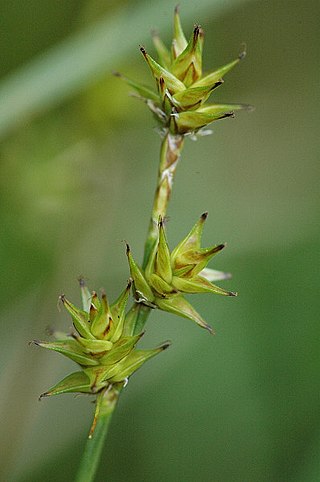
Carex echinata is a species of sedge known by the common names star sedge and little prickly sedge.

Chiton magnificus, the liquorice sea cradle, is a Southeast Pacific species of edible chiton, a marine polyplacophoran mollusk in the family Chitonidae, the typical chitons.

Raphitoma echinata is a species of sea snail, a marine gastropod mollusk in the family Raphitomidae.

Byrrhidae, the pill beetles, is a family of beetles in the superfamily Byrrhoidea. They are generally found in damp habitats within cooler-high latitude regions of both hemispheres. Most byrrhids feed on moss, lichens and algae, though some species feed on vascular plants. The oldest undoubted record of the family is Lidryops from the earliest Late Cretaceous Charentese amber of France, with other less certain records going back to the Middle Jurassic, but these possibly belong to Byrrhoidea. There around 500 extant species in 40 genera.
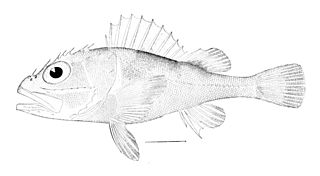
Trachyscorpia is a genus of marine ray-finned fish belonging to the subfamily Sebastinae, the rockfishes, part of the family Scorpaenidae. The species in this genus are found in the Atlantic, Indian and Pacific oceans.

Glycyrrhiza echinata is a species of flowering plant in the genus Glycyrrhiza, with various common names that include Chinese licorice, German licorice, and hedgehog licorice, Eastern European licorice, Hungarian licorice, Prickly licorice, and Roman licorice. It is used as a flavoring and medicinally, and to produce Russian and German licorice.
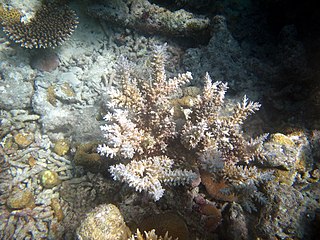
Acropora echinata is a species of acroporid coral that was first described by Dana in 1846. Found in shallow, tropical, sheltered reefs in marine environments, it is found at depths of 8 to 25 m in clear water. The species is listed as vulnerable on the IUCN Red List, and has a decreasing population. It is not common but found over a large area, and is listed under CITES Appendix II.

Acanthocardia echinata, the prickly cockle or European prickly cockle, is a species of saltwater clam, marine bivalve molluscs in the family Cardiidae.

Curimopsis is a genus of pill beetles in the family Byrrhidae. There are more than 30 described species in Curimopsis.

Cionopsis is a genus of true weevils in the beetle family Curculionidae. There are about five described species in Cionopsis.
Curimopsis setulosa is a species of pill beetle in the family Byrrhidae. It is found in North America.

Boltenia echinata, commonly known as the cactus sea squirt, is a species of tunicate, a marine invertebrate in the genus Boltenia of the family Pyuridae. It is native to the Arctic Ocean and the northern Atlantic Ocean.
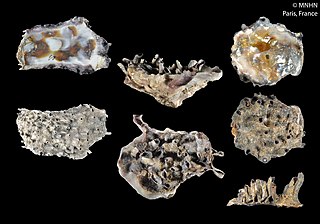
Saccostrea echinata, commonly known as the tropical black-lip rock oyster, blacklip rock oyster, blacklip oyster, and spiny rock oyster, is one of several tropical rock oyster species, occurring in tropical seas across the Indo-Pacific, including coastal waters across northern Australia to Noumea.
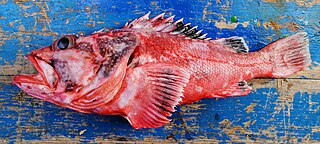
The spiny scorpionfish is a species of marine ray-finned fish belonging to the subfamily Sebastinae, the rockfishes, part of the family Scorpaenidae. It is found in the eastern Atlantic Ocean and the Mediterranean.


















